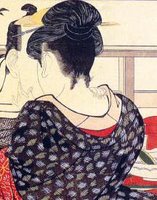

tadamasa hayashi came to paris to assist and translate in the setting up of the
paris universal exhibition of 1878.


at the time that he came, wood- block prints were quite devalued in japan, so he quickly realized that he could fill his cases with them, and sell them as art,
at art prices, in france.


thus were many people in paris introduced to japanese prints, and began collecting them.
one of these was henri riviere.
he not only bought from hayashi, but they became close friends, and hayashi became a patron for riviere.


the friendship included instruction of a sort as to printmaking methods, but it also included the recognition that riviere had,
without knowing it, revived ancient japanese printmaking methods for his own work.
when, after a close friendship of fifteen years, hayashi returned to japan, and died soon thereafter, riviere gave up printmaking.


yes, many others, as we've discussed, embraced what japan had to teach.


but to my eyes, henri riviere was japonisme's mikado.
(don't miss the wonderful photogravure site; the hiroshige site that has a permanant place in the sidebar; and the comprehensive henri riviere site.) There is a solitude of space
There is a solitude of space A solitude of death, but these
A solitude of death, but these Compared with that profounder site
Compared with that profounder site A soul admitted to itself—
A soul admitted to itself—


















































